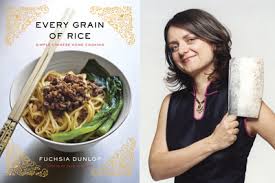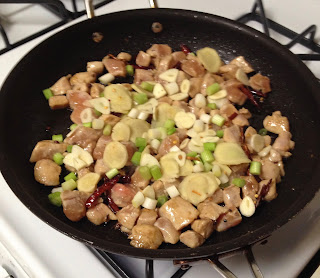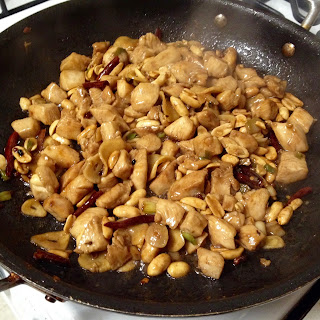| Ding Baozhen |
 |
||||
| “Every Grain of Rice” and its author. |
The version I am sharing today came from the New York Times’ Julia Moskin. She nicked it from a British journalist, Fuschia Dunlop, an authority on Chinese cuisine whose cookbook is called “Every Grain of Rice” (Norton 2012). It’s close the classic recipe and only veers away from it once. Like the original, the cooking vessel (I’d say Wok, but you don’t need one, any non-stick skillet will do) is seasoned with oil, then the chili peppers and Sichuan peppercorns are added to the oil. The chicken is stir-fried, the green onions, garlic and ginger are added. A simple sauce is poured over the dish and then roasted peanuts are tossed into the finished dish. In China, the nuts may be either peanuts or cashews. Here’s where the original recipe differs: The peanuts or cashew nuts are dropped into the hot oil on the bottom of the wok first, then deep fried until golden brown before the other ingredients are added. There are plenty of restaurant variations to this dish; sometimes orange or orange juice is added. You can also find versions that don’t use chicken at all. Beef, Pork, Tofu or Seafood are pressed into service instead. But the biggest difference between Western versions and the Chinese original is Sichuan Peppercorns. From 1968 to 2005, they were illegal to import into this country. The ban was lifted, but very few restaurant versions incorporate the peppercorns, which add immeasurably to the flavor of the dish. I served this on butter lettuce, which we used as wraps. But a bowl of steamed or fried rice would be most appropriate. Here is the recipe:
1. Cut chicken as evenly as possible into half-inch strips, then cut strips into small cubes. Place in a small bowl. Add marinade ingredients and 1 tablespoon water to bowl. Mix well and set aside.
2. Peel and thinly slice garlic and ginger. Chop spring onions into chunks as long as their diameter (to match the chicken cubes). Snip chiles in half or into sections, discarding their seeds.
3. Heat a seasoned wok or non-stick pan over a high flame. Add oil, chiles and Sichuan pepper and stir-fry briefly until chiles are darkening but not burned. (Remove wok or pan from heat if necessary to prevent overheating.)
4. Quickly add chicken and stir-fry over a high flame, stirring constantly. As soon as chicken cubes have separated, add ginger, garlic and spring onions and continue to stir-fry until they are fragrant and meat is just cooked through (test one of the larger pieces to make sure).
5. Give sauce a stir and add to wok, continuing to stir and toss. As soon as the sauce has become thick and shiny, add the peanuts, stir them in and serve.

















